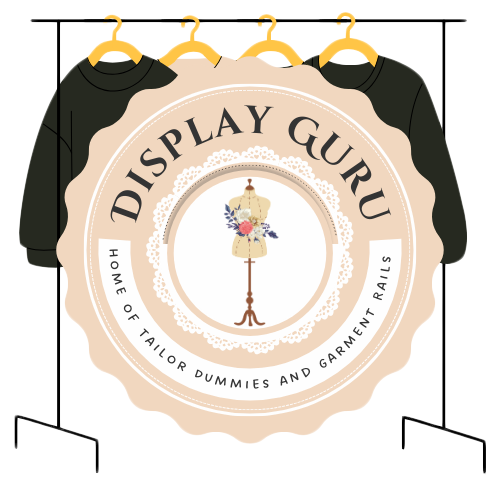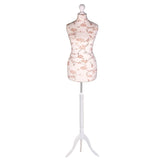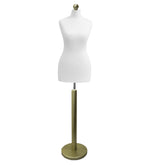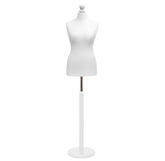Choosing an Adjustable Child Dress Form
If you’ve ever tried to sew for a child, you know the struggle. They wriggle, they grow overnight, and getting a perfect fit can feel like trying to hit a moving target. That’s where an adjustable child dress form comes in. Think of it less like a static mannequin and more like a 3D blueprint of a child's body. It provides a reliable, consistent shape to work on, saving you countless hours of frustrating fittings and rework.
For anyone serious about creating professional-quality clothes for children, it’s an absolute game-changer.
Why a Dress Form Is Your Most Valuable Sewing Partner
Imagine trying to build a bespoke piece of furniture without a workbench or proper measurements. You'd be guessing at every cut, leading to a wobbly, ill-fitting result. That’s exactly what sewing for a growing child feels like without the right dress form. Kids grow in unpredictable spurts, making standard paper patterns a constant source of guesswork.
An adjustable child dress form takes that guesswork out of the equation. It becomes your silent, endlessly patient fitting model, standing perfectly still while you drape, pin, and fine-tune your designs. This isn’t just a display piece; it’s an active partner in your creative process.
From Guesswork to Precision Engineering
The fundamental problem an adjustable form solves is inconsistency. A child's measurements can shift in a few short weeks, and as any parent knows, getting them to stand still for one fitting is hard enough, let alone several. The dress form gives you a stable, dependable 3D replica of their unique shape.
This simple shift changes your sewing from a trial-and-error game into something much closer to precision engineering. You can immediately see how a fabric will hang, check the placement of a seam, and make confident alterations before you even touch your final, expensive fabric. The result? Beautifully fitting clothes and far less wasted time and material.
Here's a quick look at the core benefits.
| Advantage | Description |
|---|---|
| Consistent Sizing | Provides a stable set of measurements that won't change, unlike a growing child. |
| Improved Fit | Allows for 3D draping and pinning, ensuring garments follow the body's natural curves. |
| Time Savings | Drastically reduces the need for multiple live fittings, speeding up the entire process. |
| Creative Freedom | Makes it easier to experiment with designs, adapt patterns, and see your vision come to life. |
Ultimately, a dress form empowers you to work with confidence, knowing the final piece will fit just right.
A Growing Market for a Timeless Craft
The demand for these specialised tools is growing right alongside the fashion world itself. The UK childrenswear market is valued at approximately £7.85 billion as of 2025, a figure that holds steady because, well, children always need clothes. As this market continues to thrive, so does the need for professional tools that help creators and small businesses stand out.
"A dress form bears the imprints of past creations, every pinhole and seam a testament to your relentless pursuit of perfection."
Using an adjustable child dress form bridges the gap between a flat, two-dimensional pattern and the three-dimensional garment it’s meant to become. It lets you work in the round, just as the final piece will be worn. For anyone looking to elevate their craft, understanding the different types of forms is crucial. If you're curious, you might want to read our complete overview of adjustable dress forms for sewing, which explores a wider range of models and their features.
This tool is especially vital for:
- Creating Bespoke Garments: For a wedding, christening, or any other special occasion, a perfect, tailored fit is essential.
- Adapting Patterns: It makes it so much easier to tweak commercial patterns for children who don't fit standard size charts.
- Small Business Production: For makers selling their creations, a dress form ensures consistency and quality control across every item in a collection.
When you invest in an adjustable child dress form, you're really investing in your own skill, your efficiency, and the professional quality of your work. It quickly becomes your most reliable assistant, helping you bring your creative visions to life with precision and flair.
How Sizing and Adjustments Actually Work
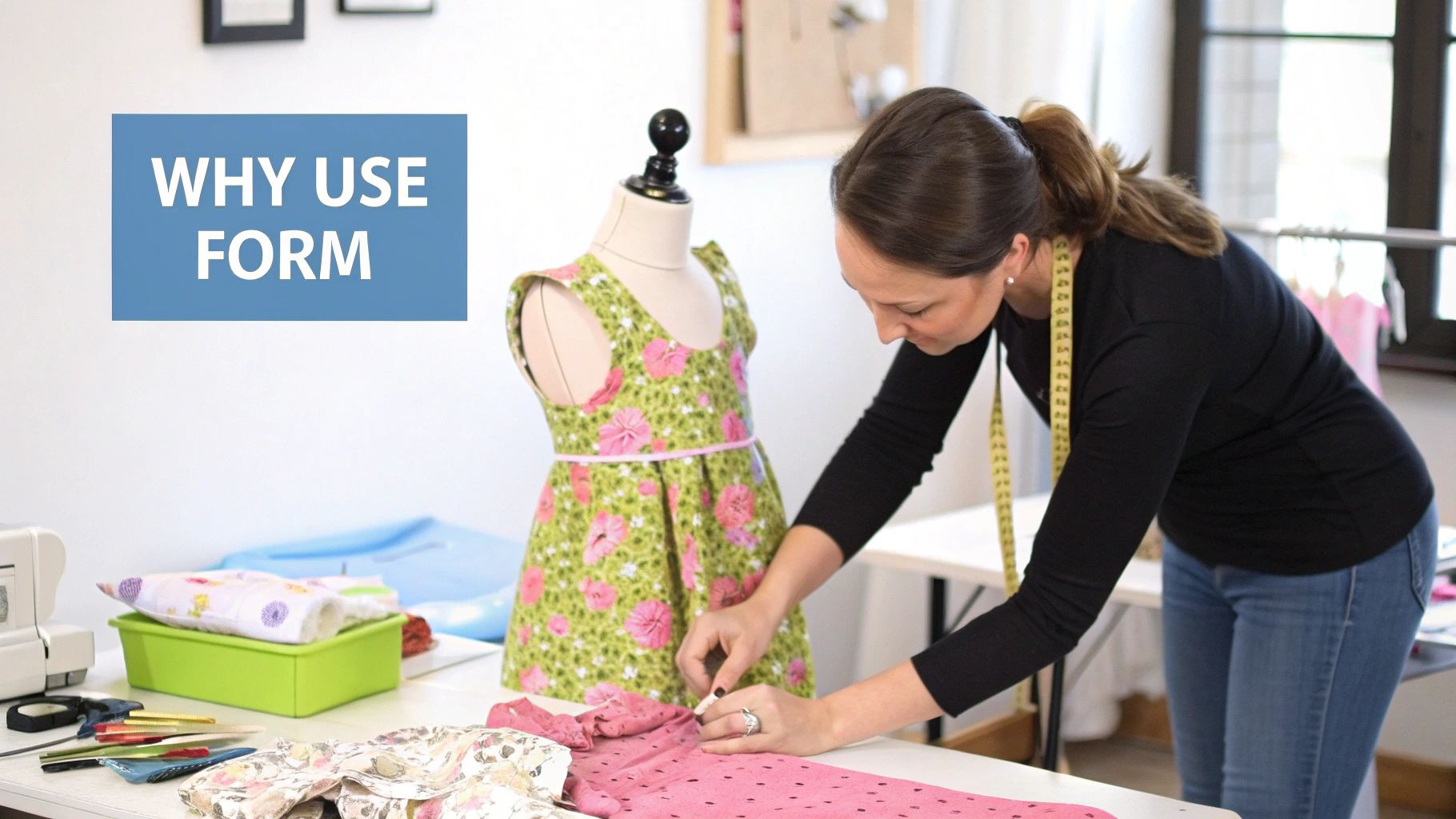
Getting to grips with the technical side of dress forms can feel a bit daunting, but the way they work is far simpler than you might think. The trick is to stop seeing an adjustable child dress form as a single, solid object. Instead, picture it as a clever collection of panels that can glide apart or together to perfectly mirror a child's unique shape. This ability to transform is what makes it such a vital tool in any sewing room.
Imagine it's a bit like a 3D puzzle. The mannequin’s torso is split into several vertical and horizontal sections. When you turn one of the adjustment dials or keys, you’re simply pushing these panels further apart or pulling them closer, changing the overall circumference at key points like the bust, waist, and hips. This mechanism is the engine that brings the form’s customisation to life.
Translating Measurements into a 3D Shape
The very first step is bridging the gap between a tape measure and the physical form. While manufacturers often use broad labels like ‘Junior’ or ‘Petite’, these are just guides. What truly matters is the specific measurement range given for the chest, waist, and hips.
Before you even start shopping, you need a precise set of the child's body measurements. Taking accurate measurements is a skill in itself, so we've put together a guide on how to take body measurements for clothes that walks you through the process step-by-step. With those numbers in hand, you can confidently choose a form whose adjustment range comfortably accommodates them.
Here’s a golden rule I always follow: it’s much better to buy a form that’s slightly smaller than the child's measurements than one that’s too big. You can always add padding to build up an area, but you can’t make a dress form smaller than its minimum setting.
Sticking to this principle gives you the greatest flexibility to create a truly bespoke fit.
Understanding the Adjustment Mechanisms
The real magic of an adjustable child dress form is hidden in its adjustment system. Although you'll find different designs on the market, they generally fall into two main categories, each with its own distinct feel and function. Knowing the difference will help you pick a model that suits your personal workflow.
Dial-Based Systems
These are the most common you’ll find, and for good reason—they offer incredibly detailed control.
- How They Work: You’ll see multiple dials (usually 8 to 12 of them) dotted around the bust, waist, and hip areas. Turning each dial expands or contracts a specific section of the form.
- Best For: Precision work. Think of it like a graphic equaliser for sound; you can fine-tune each dimension independently to match a very specific, nuanced shape. This is brilliant for capturing unique body proportions.
Key-Operated Systems
This type uses a single, dedicated tool for making all the adjustments.
- How They Work: A special key fits into slots across the body. A simple turn of the key engages the internal gears, delivering a smooth and controlled adjustment.
- Best For: Durability and ease of use. It can feel quicker than fiddling with multiple dials and is often more robust, which helps prevent the settings from being knocked out of place accidentally.
The bottom line is that your goal is to create a 3D canvas that faithfully represents the child's body. Whether you prefer the granular control of dials or the straightforward simplicity of a key, the result is the same: a perfect foundation for draping, pattern-making, and fitting. It’s what turns the guesswork of sewing for growing bodies into an art of precision.
Once you’ve got a handle on sizing and adjustments, it’s time to look at the features that really separate a decent tool from a great one. An adjustable child dress form is more than its measurement range; its build quality and handy extras directly affect how smoothly your projects go and how professional they look. Knowing what to look for means you'll invest in a dress form that will be a reliable partner for years.
It’s worth remembering that not all dress forms are created equal. Some are just for display—their hard plastic shells look the part but are a nightmare to actually work on. For sewing, you need a form designed for the hands-on process of draping, pinning, and fitting. This is where the right materials and design truly matter.
The Foundation: A Stable Base
First things first, check the stand. It might seem like a small detail, but trust me, there's nothing more frustrating than a wobbly base when you’re trying to work precisely. A form that sways or tips over while you're draping fabric can completely throw off your rhythm and even damage your work.
Look for a base with either three or four legs—a tripod or quad-base. This wider footprint gives it the stability it needs to stay put while you move around it. Many of the better models also come with castors, which are fantastic for wheeling the form around your studio. Just make sure they have locks to hold it firmly in place when you need it to be still.
The Surface: A Pinnable Cover
The material covering the torso is probably the most important feature for anyone who sews. A hard, unforgiving surface just won't cut it for pattern making. You need a form that you can stick pins into confidently and directly.
- Foam-Backed Nylon Cover: This is the gold standard for a reason. A thin layer of foam under a tough nylon or linen cover lets you push pins straight into the dress form's body. This is absolutely essential for draping fabric and holding pattern pieces securely.
- Hard Plastic Shells: You'll typically find these on cheaper display mannequins. They're fine for showing off finished outfits but are useless for sewing because you can't pin into them.
A truly pinnable surface gives you the freedom to work right on the form, saving you time and ensuring your garment pieces are held exactly where they need to be. You can dive deeper into this in our ultimate fitting guide for an adjustable mannequin.
The image below really drives home why getting accurate measurements is the crucial first step, long before you start using any of these features.
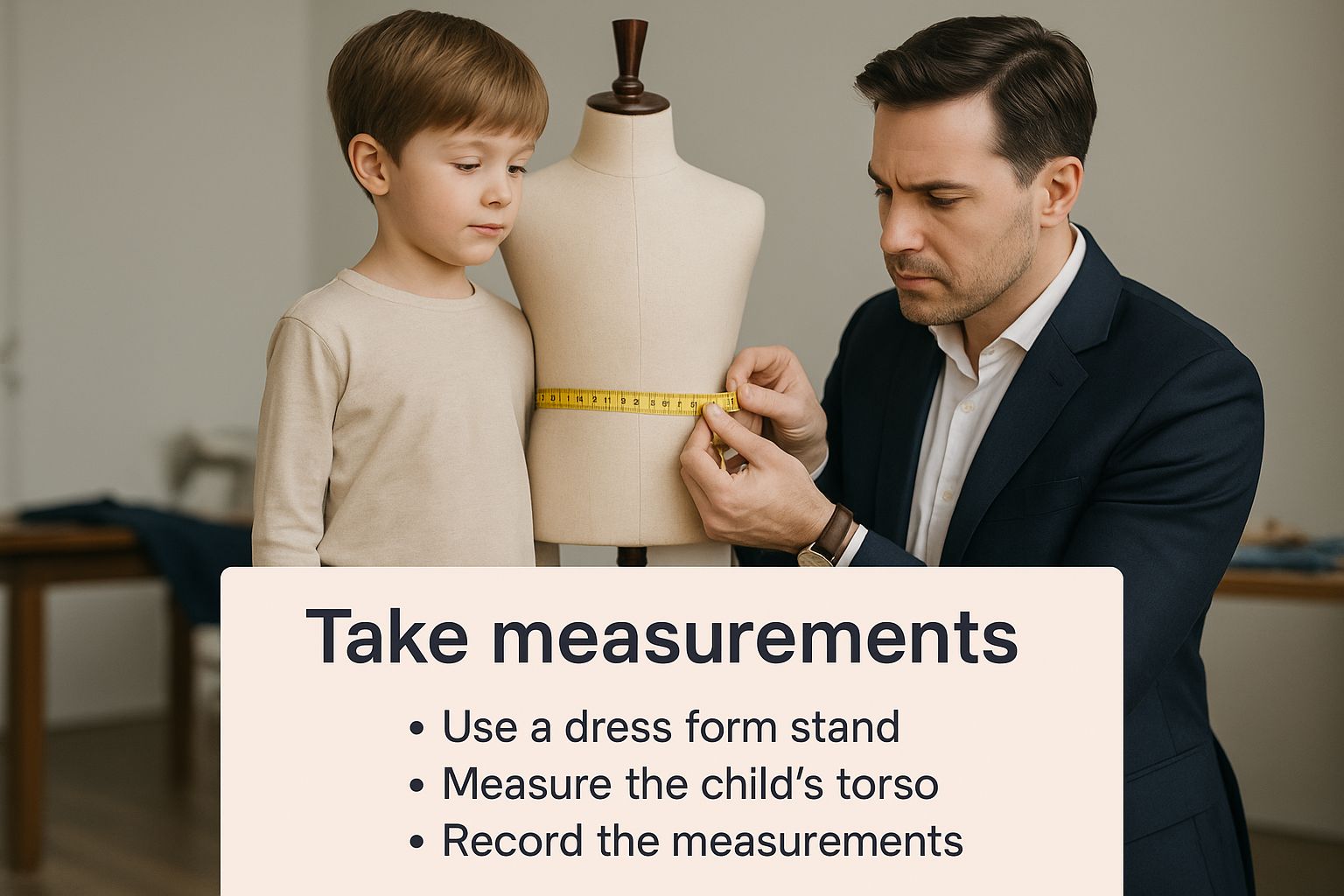
This visual is a great reminder that even the best dress form is only as good as the measurements you start with.
The Finishing Touch: The Pin Hem Marker
Getting a perfectly straight, even hem is one of the most tedious tasks in dressmaking. Trying to do it on a wriggly child? Nearly impossible. This is where a built-in hem marker becomes a secret weapon.
A pin hem marker is a simple attachment that clips onto the central pole of the stand. It holds a pin or chalk precisely at your chosen height, allowing you to rotate the form and mark an impeccably level hemline all the way around the garment.
This little feature alone can save you hours of frustration and guarantee a professional finish every single time. It’s a small detail that makes a huge difference, turning what is often a fiddly, inaccurate job into a quick and simple step. When choosing your adjustable child dress form, focusing on these practical features—a stable base, a pinnable cover, and a hem guide—will elevate your sewing from a hobby to a high-quality craft.
Setting Up and Customising Your Dress Form for a Perfect Fit
Unboxing your new dress form is exciting, but that's just the start. The real magic happens when you turn that generic mannequin into a precise body double for a child. This setup and customisation process is what makes the difference between a good fit and a perfect one – it's how you turn a simple tool into your most trusted fitting assistant.
The initial assembly is usually quite simple. Most models just require you to fix the central pole into the base and then place the torso on top. It’s tempting to rush this part, but take a moment to make sure every screw is tight and the stand is perfectly level. This little bit of care now will save you from a frustrating wobble later on. For more detailed tips on this, our guide on different dress form stands can help you achieve maximum stability.
With the form assembled, it’s time to translate the child's measurements onto the dials.
Making the Initial Adjustments
This is where those careful chest, waist, and hip measurements you took come into play. A good habit is to start with all the adjustment dials on your adjustable child dress form wound down to their smallest setting. From there, you can methodically expand each section, one at a time, until the form’s measurements match the child’s.
I find it easiest to work from the top down. Start with the neck and chest, move on to the waist, and finish with the hips. Keep a soft tape measure handy and check your progress frequently. Don't stress about getting it spot-on in one go; this is all about making small, incremental changes until it's just right.
Remember, the dials create the basic circumference, but they don't capture the unique contours of a real person. This initial setup builds the skeleton; the next step, padding, is what gives it flesh and truly brings it to life.
The Art of Padding Out for a Lifelike Shape
Even the best adjustable dress forms have a somewhat idealised, often angular shape. Children, as we know, have softer curves, little tummies, or unique shoulder slopes. Padding is the professional technique we use to bridge that gap and sculpt a truly custom silhouette.
Think of yourself as a sculptor adding clay. You’re building up specific areas of the form to perfectly mirror the child’s body. This is, without a doubt, the most crucial step for getting a flawless fit, particularly for close-fitting clothes.
The goal of padding isn't to make the form bigger all over, but to add shape and dimension exactly where it's needed. A well-padded form is the secret behind garments that look custom-made rather than simply 'off the rack'.
To get started with padding, you’ll need a few supplies.
- Shoulder Pads: Excellent for building up narrow or sloping shoulders.
- Polyester Batting or Wadding: This is your go-to for adding soft volume to areas like the tummy, bust, or upper back.
- A Padded Dress Form Cover: This is a stretchy, zip-up cover that goes over the entire form. It's essential for holding all your padding securely and giving you a smooth, pinnable surface to work on.
Begin by identifying where the child's shape differs most from the form. Does the child have a fuller tummy? Layer thin sheets of batting over that area. Are their shoulder blades more prominent? Add some padding to the upper back. You can use pins to hold the pads in place temporarily as you build up the shape.
The final step is to carefully pull the padded cover over the form, zipping it up to smooth everything out and hold your work firmly in place. What you have now is no longer just an adjustable child dress form; it's a true body double, ready to ensure every seam, dart, and drape on your next project is absolutely perfect.
Bringing Your Creative Projects to Life
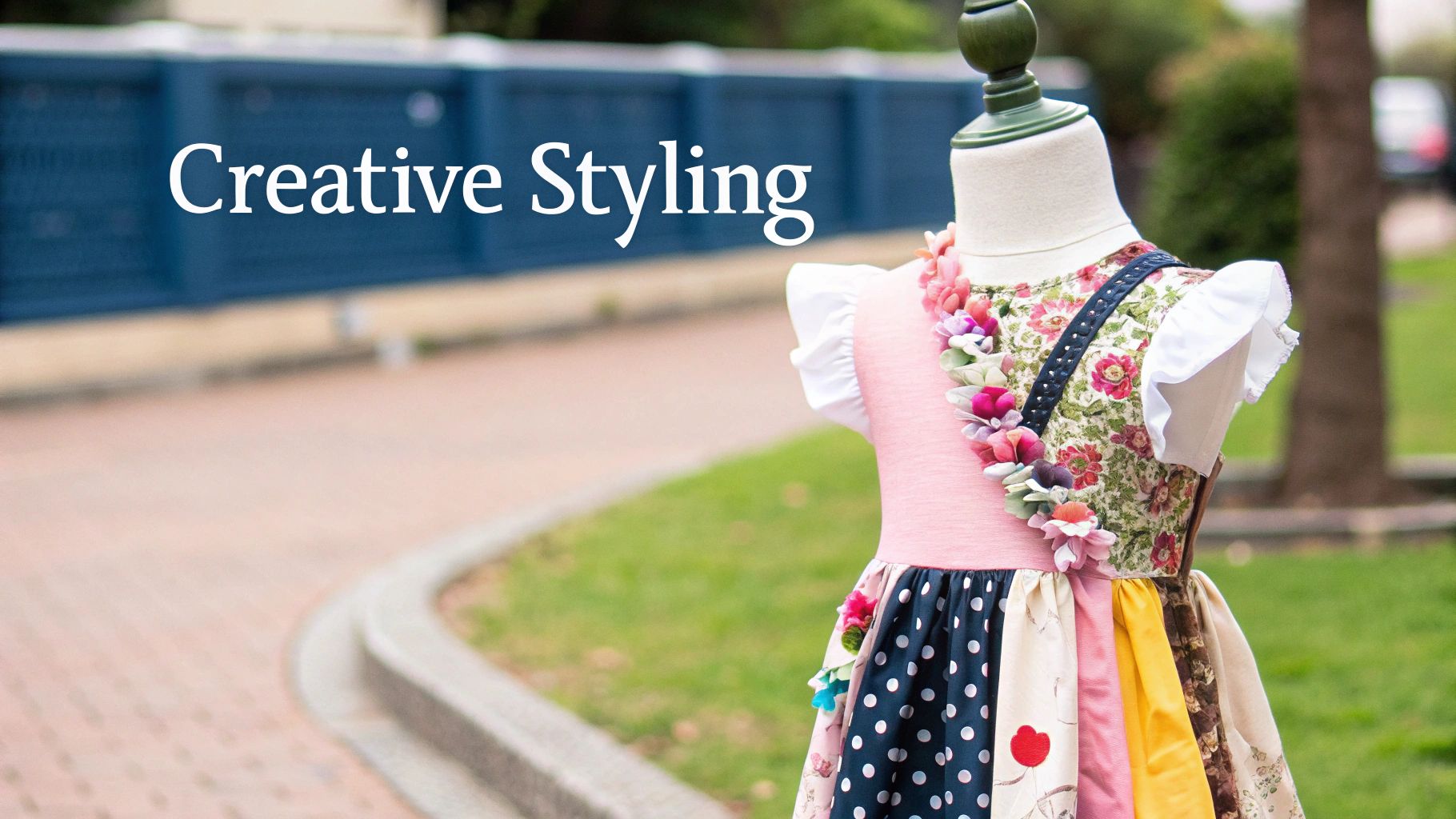
Once your dress form is padded out and dialled into the right measurements, it transforms from a simple stand into a silent, patient collaborator. This is the moment the theory becomes practice, where you can truly see how an adjustable child dress form elevates the quality of your sewing. It’s the difference between crossing your fingers for a good fit and confidently engineering one from the start.
So, let's look at a few real-world scenarios where this tool proves its worth, again and again. These examples show just how it helps you navigate common sewing challenges with precision, turning potential headaches into creative successes.
Case Study: Tailoring a Flawless Flower Girl Dress
Picture this: you've been asked to create a flower girl dress for a family wedding. The fit needs to be immaculate, but the child lives hundreds of miles away, making multiple in-person fittings completely out of the question. This is exactly the kind of high-stakes situation where your dress form becomes your most valuable asset.
After setting the form to the child's exact measurements and padding it to mimic her posture, it becomes your stand-in model. You can drape the delicate satin bodice directly onto the form, making sure the neckline sits perfectly and the princess seams are flawlessly placed. There's no guesswork.
When it's time to attach the multi-layered tulle skirt, you can pin it evenly around the waistline, checking the volume and hang from every angle—all without the child needing to be there.
With a project like this, precision is everything. The dress form allows you to work on the garment over several days, ensuring every detail is flawless—from the button placement on the back to the final hemline—all with the confidence that it will fit like a glove on the big day.
This approach transforms what could be a stressful job into a controlled, enjoyable process. The finished dress isn't just beautiful; it's a testament to the accuracy your dress form makes possible.
Adapting Patterns for Non-Standard Proportions
Let’s be honest, commercial sewing patterns are designed for a ‘standard’ child that rarely exists in real life. This is a common frustration for sewers at every level. An adjustable child dress form is the ultimate problem-solver for this very issue.
Think about a child who is tall and slender, with a torso length that matches a size 8 but a waist that’s closer to a size 6. Trying to blend these sizes on a flat paper pattern is confusing and often results in an awkward, ill-fitting garment.
With your customised form, however, the solution becomes visual and intuitive. You can see exactly where the standard pattern falls short.
- Visualising Adjustments: Simply place the pattern pieces against the form to see immediately where you need to add or remove width.
- Perfecting Darts: You can pin the pattern tissue directly onto the form and redraw darts so they point correctly to the child’s actual apex.
- Checking Proportions: It allows you to assess the overall balance, ensuring the waistline sits at the natural waist, not too high or too low.
This hands-on method makes pattern alterations feel less like maths and more like sculpting. It empowers you to create bespoke clothing that truly flatters a child's individual shape.
Aiding Small Business Quality Control and Marketing
For anyone running a small business selling children's clothing online, an adjustable child dress form plays two crucial roles: it guarantees product consistency and helps create beautiful product photography. Consistency is the key to building a reputable brand and, importantly, reducing returns. The form acts as your master template for every size you produce.
This level of precision is becoming more important as the children's apparel market grows. In the UK, the children’s dresses and skirts sector is projected to expand with a compound annual growth rate of around 5.8% between 2025 and 2030. You can read more about the UK children's clothing market trends to get a feel for the evolving landscape.
What's more, a dress form lets you take clean, professional-looking product photos that clearly show off a garment's fit and drape. This consistent presentation across your online shop helps customers visualise how an item will look, building their confidence and boosting sales. From quality control to marketing, a dress form is an invaluable asset.
Right, let's look after your most important assistant. A good quality adjustable child's dress form isn't just a purchase; it's an investment in your work. And like any professional tool, a little bit of care will keep it working accurately for you project after project, for years to come.
Think of it like your favourite pair of fabric shears – you wouldn't use them to cut cardboard or leave them out to rust. Your dress form deserves that same respect. A simple maintenance routine is all it takes to protect its delicate mechanisms and keep it as a reliable partner in your studio.
Keeping It Clean and Ready for Work
It’s inevitable: your dress form’s fabric cover will pick up dust, stray threads, and the odd chalk mark. Keeping it clean is straightforward, but the key is to be gentle. A quick once-over with a lint roller or the soft brush attachment on your vacuum is perfect for day-to-day upkeep.
What about more stubborn marks? Steer clear of harsh chemical cleaners. They can eat away at the fabric and the foam underneath, causing damage you really don't want.
The best solution is often the simplest. A bowl of lukewarm water with a single drop of mild detergent is all you need. Dip a microfibre cloth in, wring it out so it's just damp, and gently dab the mark. Never scrub. Afterwards, let the form air dry completely before you even think about using it again.
This gentle touch keeps the cover fresh without weakening it.
Looking After the Adjustment Mechanisms
The dials and gears inside are the real magic of your adjustable child dress form. Keeping them running smoothly is non-negotiable. When you're changing the measurements, always turn the dials slowly and deliberately. Trying to force a stiff dial is a fast track to stripping the plastic gears inside, which can be a nightmare to fix.
If a dial feels stuck, stop. Don't force it. Instead, give the corresponding body panel a little wiggle to help free things up, then try turning the dial again. It’s a simple trick that prevents putting too much strain on the whole system. It's also a good idea to avoid leaving the form set to its absolute maximum size for long stretches, as this keeps constant tension on the internal parts.
Here are a few more pro tips to keep your dress form in top shape:
- Store it properly: Keep your form out of direct sunlight, as the UV rays will fade and weaken the fabric over time. A simple dust cover is a great idea for when it's not in use.
- Check the stand: Every so often, check that the screws on the base and pole are tight. A wobbly stand is not just annoying, it's a hazard.
- Handle with care: When you need to move it, always lift it by the main central pole. Grabbing it by the shoulders or torso sections can damage the adjustment points.
Common Questions About Child Dress Forms
Diving into the world of dress forms can stir up a few practical questions. Let's face it, getting clear, straightforward answers is what gives you the confidence to choose the right one and use it well. Here, we’ll tackle some of the most common queries that come up for sewers and designers looking at an adjustable child dress form.
Think of this as your friendly guide to clearing up any final doubts. We'll demystify a few common points of confusion, making sure you feel ready to make a great decision and get the most out of your new sewing companion.
Can I Use a Child Dress Form for Making Trousers?
Yes, you absolutely can, but you'll need a slight change in approach. A standard torso form is actually perfect for nailing the most critical parts of any pair of trousers: the waist, the hips, and the rise (that crucial measurement from crotch to waist). These are often the trickiest areas to get just right.
For the legs themselves, you have a couple of options. Some top-tier professional brands do offer bifurcated forms, which have split legs designed specifically for trousers. The more common method, however, is to use the torso form to get a perfect fit up top and then rely on your flat pattern measurements for the inseam and thigh.
What Size Should I Buy if a Child Is Between Sizes?
This is probably the most frequent—and important—question we hear. The answer is refreshingly simple: always opt for the smaller size. Remember, an adjustable form can only expand outwards from its smallest base measurements.
You can always add padding to a smaller form to build it up and customise the shape to perfectly match a child. But you can never, ever shrink a dress form that's already too big. Going smaller gives you far more flexibility.
Is a More Expensive Dress Form Always Better?
Not necessarily. The "best" form is simply the one that fits your specific needs. It's true that pricier models often boast more adjustment points (like back length), better stability, and more durable materials, but these features can be overkill for a hobbyist.
If you're a professional designer or someone who sews constantly, that extra investment is probably a wise one. For most hobbyists, however, a quality mid-range model with a solid, stable base and a pinnable fabric cover is more than enough to achieve fantastic results. If you need more help weighing up the features, our article on how to buy a dress form offers a detailed checklist.
How Do I Add Growing Room When Using a Dress Form?
The smartest approach here is to use the dress form for what it does best: creating a garment that fits the child perfectly right now. The form's job is to guarantee an impeccable current fit.
To build in that all-important "growing room," you make your adjustments at the pattern-cutting stage, not on the form itself. For instance, you could add an extra 1-2 cm to the side seams and perhaps 3-5 cm to the hem length. This method gives you the best of both worlds: a beautifully tailored fit today with room for tomorrow's inevitable growth spurt.
Ready to achieve that perfect fit on every project? At Display Guru, we offer a professional range of adjustable dress forms to support your creativity. Explore our collection of child dress forms and find your ideal sewing partner today.
